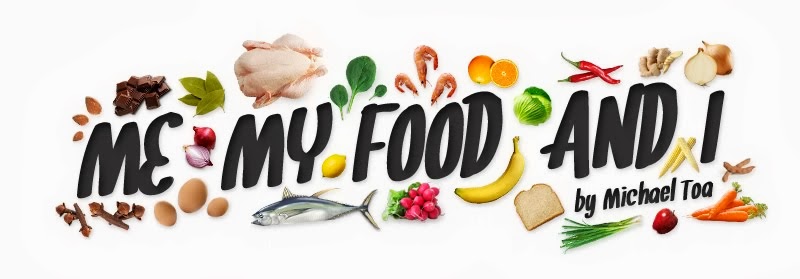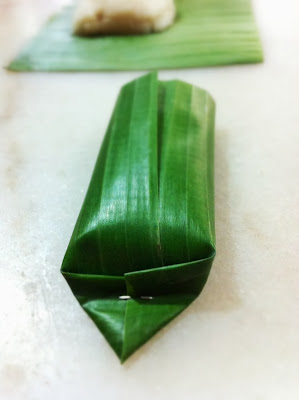Glutinous rice roll with chicken or known as lemper ayam in Indonesia is one of my favourite anytime snacks. I love it when I was a kid and I still love it today... especially now that I can make these little parcels of deliciousness on my own and I want to share it with all of you...
I was quite surprised that these rice rolls are easy to make and please don't be put off by the lengthy explanation. It does take patience which if you know me, I have none... but actually after a while, the repetitive activity of rolling and wrapping become somewhat therapeutic. And it requires practice to shape the rolls. My first few rolls were a bit wonky, but after making hundreds of these (yes, seriously), they look just like the real deal :)
So let's get to it... First job is to soak the glutinous rice in water. The rice needs to be soaked because the grains are harder. Soak it at least a couple of hours prior to cooking or longer if you can remember. Now, make the filling. Here I use chicken, but if you prefer, beef, pork or prawns are delicious too. Despite my love for chicken thighs, this time I use chicken breasts because I think they shred better. There are also recipes that use minced chicken, but I prefer the texture of the shredded chicken.
Poach a couple of chicken breasts (skin-on, bone-in) in plenty of water until it is cooked through. Let it cool a bit, remove the skins and bones and shred using the method of your choice. Save the poaching liquid. We're going to use it to cook the rice.
To make the bumbu for the chicken, in a blender add in 3 shallots, 3 cloves of garlic, 2 tsps coriander seeds, 1 tsp cumin seeds, 3 candlenuts and kencur. Let's talk about that last ingredient... Kencur (sometimes spelled kentjoer) or known as kaemferia galanga in Latin (sounds like a spell from Harry Potter doesn't it?) or zedoary in English is a root plant related to ginger and turmeric (sometimes referred to as white turmeric). It is fragrant like one of those aromatherapy oil. It has a warm taste like ginger but also bitter, so use it sparingly. If you can get hold of it, great... but if not, I'd use ginger or galangal.
Question of the day: have you came across kencur/kaemferia galanga/zedoary before?
Question of the day: have you came across kencur/kaemferia galanga/zedoary before?
Blend the spices with a little water until smooth. Gently fry the bumbu in a pan with vegetable oil until fragrant. Then add the shredded chicken and toss it around, making sure it is all coated with the spices. To this, add coconut milk, finely cut kaffir lime leaves (be generous with it) and season with salt, white pepper and a good sprinkling of sugar. Not too sweet that this becomes a pudding, but just enough to balance all the flavours. Let the mixture simmer for a bit until all the spices is absorbed. Give it a stir every now and then. The important thing is to make sure the filling is not completely dry. Taste and adjust the seasoning. The filling can now be put to one side to cool... or actually this can be made the day before and keep in the fridge. This amount of filling should be enough for approximately 25 rice rolls.
If you want to add curry powder to the filling, go for it. It's actually really nice as well.
Cooking glutinous rice is very simple especially since I use a rice cooker. Drain the rice of its soaking water and rinse it thoroughly. Cook the rice using the reserved chicken poaching liquid, coconut milk and season with salt. To make the rice even more fragrant, also throw in a couple of pandan leaves. For every cup of rice, I use one and a half cup of chicken poaching liquid and half a cup of coconut milk.
If you want to add curry powder to the filling, go for it. It's actually really nice as well.
Cooking glutinous rice is very simple especially since I use a rice cooker. Drain the rice of its soaking water and rinse it thoroughly. Cook the rice using the reserved chicken poaching liquid, coconut milk and season with salt. To make the rice even more fragrant, also throw in a couple of pandan leaves. For every cup of rice, I use one and a half cup of chicken poaching liquid and half a cup of coconut milk.
While the rice is cooking, prepare the banana leaves. I don't know how accessible is banana leaves where you live. I get mine from the farmers market. If you can get it, that's awesome. But if you can't, plastic wrap or non-stick parchment paper is an option, but it just won't have the same effect. If using banana leaves, trim the edges and cut into rectangles Wipe both side of the banana leave with a damp cloth.
Place the leaves with the stripes going horizontal facing you as pictured below. When the rice is cooked, let it cool a little, but not completely cold. It's easier to shape the rice while it's still warm. And because I want the rolls to be the same size, I weigh the rice on the banana leaf... 50 gr of rice for each roll is just the right couple of bites for snacking. Now, use a plastic spoon to flatten the rice to a rectangular shape. The reason I use plastic spoon is because the rice don't stick as much to plastic as opposed to stainless steel cutlery.
Place the shredded chicken to one end of the rice. There is a temptation to put as much filling as possible... but don't. Too much filling and the roll will burst. Believe me, I know. A couple teaspoons of the filling is plenty.
With the help of the banana leaf, lift the rice and shape it into a mound covering the filling on all sides.
Fold the banana leaf as if you're wrapping a present. Do this tightly but gently, trying not to rip the leaf. You can secure the end using a small cocktail stick or toothpick, but I find using a stapler is much easier.
Completely for aesthetic value, I trim the edges with scissors. I just think they look neat this way... and guess what, we're almost at the end :)
Using a non-stick pan, heat a tablespoon or so of vegetable oil over a medium heat and fry the parcels just until the skin is nicely charred on both sides. Leave the lemper to cool a bit... it's best eaten warm or at room temperature. Should you have any leftovers, store in the fridge and re-heat in the microwave.
So, there you go... I hope you enjoy this post and are inspired to try it at home. Have a wonderful weekend friends! I haven't got anything special planned but I'm sure I'll find something to do in the kitchen. x










